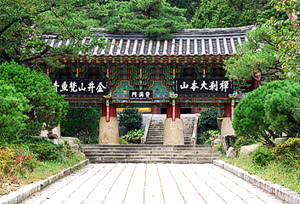About Beomeosa
About Beomeosa

A temple to purify your mind…
Korea’s original temple of Seon Buddhism

Beomeosa was built by the great master Uisang (625-702 CE) in 678 during the reign of Silla’s King Munmu as one of ten Hwaeom temples in Korea. It was established to realize the goal of the Hwaeom tradition which pursues a life of happiness and generosity.
Some of the great masters who studied and practiced here include: Uisang, Wonhyo, Pyohun, Nangbaek, Myeonghak, Gyeongheo, Yongseong, Seongwol, Yongun, and Dongsan. Master Dongsan led the Buddhist Purification Movement (1954-1962) and worked as a driving force to modernize Buddhism in Korea.
Beomeosa is a Seon meditation-based temple, a place where people can meditate and clear their mind. Through meditation, all pointless and distracting thoughts are vanquished, allowing people to look into their true inner-self and find their inner source, after which they can realize their true Buddha-nature.
Home to Buddhist cultural assets and eminent monks, there are three National Treasures at Beomeosa: the temple’s One Pillar Gate (No. 1461), Three-story Stone Pagoda (No. 250), and the Main Buddha Hall (No. 434) that was established in 1614 by Ven. Myojeon during the Joseon Dynasty.
Foundation History of Beomeosa
In the historical record Survey of the Geography of Korea (Dongguk yeoji seungnam), the origin of Beomeosa is recorded as follows: “At the top of Mt. Geumjeongsan is a golden well that never dries, even during drought. To play in the well a gold-colored fish descended from heaven riding on clouds of the five elementary colors, so people called the well Geumsaem (gold spring).” The mountain was named after the well, and Beomeosa means “Temple of Gold Fish from Brahma Heaven”
SeonChalDaeBonSan
SeonChalDaeBonSan means a place where people can meditate and clear their mind. Through meditation, all useless ideas can be vanished and people can look into their true inner-self and realize their Buddhist mind. When Buddhist priest SeongWol worked as the abbot of Beomeosa during the Greater Korean Empire period, the priestdeclared Beomeosa as main temple practicing meditation and invited great Buddhist priest GyeongHeo as the master teacher for Beomeosa Zen center. Everyone has their own thought and mind. If we practice meditation enough, even silly average person can be Buddha. There are three jewel monasteries.The Buddha jewel monastery is Tongdosa, the Dharma jewel monastery is Haeinsa, and the Sangha jewel monastery is Songgwangsa. In that sense, Beomeosa can be the fourth Meditation(Seon) jewel monastery where people can find the root of their arising thought and mind.
Jo Gye Mun(Il Ju Gate)

It is also called as Il Ju Gate or One-Pillar Gate. The gate was built in a row with stone pillar by Master Myo Jeon in 1614. It is the first door that leads to the sacred world of Buddha. As the world of truth has no discrimination, it is said that people coming into the door have to leave their discriminative ideas behind. Our original nature is as clear as blue sky, but it gets tainted in the mundane world. The hanging board reads "SeonChalDaeBonSan Beomeosa" and the gate is the best gate ever founded in Korea, being designated as treasure.
Dae Woong Jeon (Buddha Hall) –Treasure No. 434

The hall enshrines Sakyamuni Buddha and the name of Dae Woong was originated from Lotus Sutra (Beop Hwa Gyeong). Dae Woong is the virtuous name of the Buddha, meaning great hero who renounced all worldly desiresand reached enlightenment. Beomeosa Buddha Hall has JeHwaGalLa bodhisattvaMiReuk bodhisattvaon both sides. JeHwaGalLa saint is the presence of the Buddha of the past and MiReuk is the presence of the Buddha of the future. Therefore, the templehas enshrined the Buddha of the past, present, and future to save people from their agony in transcending the time. The hall was established in 1614 by Buddhist priest MyoJeon during the Jo Seon Dynasty.

